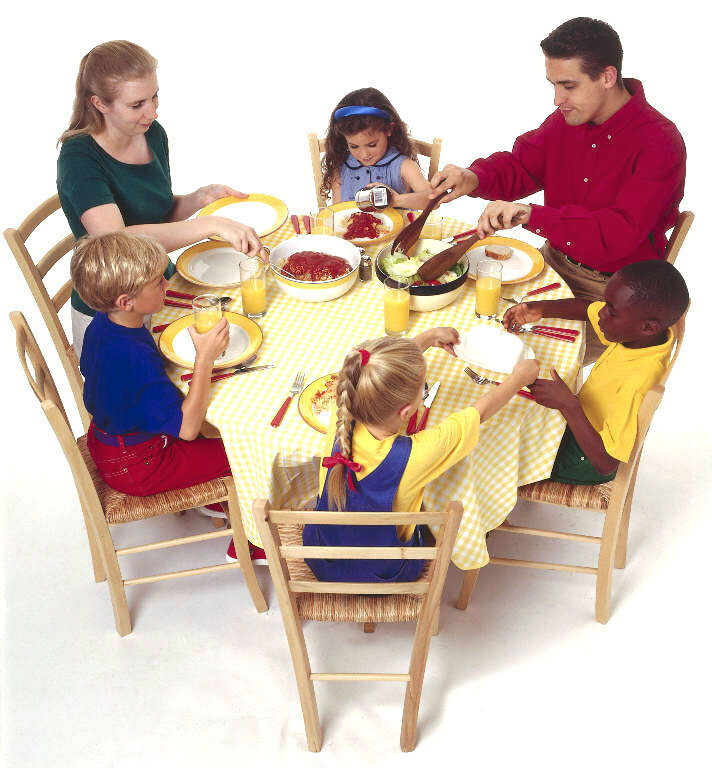First Family Meals for Fostering and Adopting Families
A reader asks:
"As we near time to bring home 2 kids on visitor's visa whom we are adopting who are selective eaters, I'm trying to make sure I have a plan in place with regards to safe foods being offered at each meal. They favor noodles, pizza (which we all can eat), hotdogs, and blini and cheese on bread or separate and yogurt & cucumbers and pickles. Do I just make sure we have noodles or pizza or blini or cheese or hot dogs at each meal in addition to the foods that my other 2 kids and my hub. and I want to serve/eat (like meatballs, veggies, etc)."First of all, I am so happy that you are thinking about all of this in advance, and that you are focusing on family meals, and keeping the needs of everyone at the table in mind. Family meals can be an amazing opportunity for completing those bonding cycles, by meeting a child's need over and over. Meals are also repetitive, sensory-based and relationship building (important characteristics of bonding opportunities according to Dr Bruce Perry of the Child Trauma Academy.) While meals are an opportunity to strengthen attachment, as you allude to in your question, the family table can also be a place for confusion and even conflict. Being prepared in advance makes a big difference! Many parents say they felt blind-sided by the challenges at the table!You seem to have more information than many families have who may be fostering or waiting to bring their children home, which is great and you are thinking about it all in advance. Since you know several favored foods, planning on serving at least one favored food with every meal and snack in the beginning is a great idea. Avoiding pressure and power struggles over food is critical, and will help all your children eat better, and will help you build trust and attachment with your adopted children. I will answer some specifics, and offer some general thoughts as well, and stay tuned for a sample menu at the end...
- If noodles are familiar, consider serving them different ways: plain with possible sides like cheese, butter or tomato sauce, or cold with a mild dressing like a pasta salad. Using familiar foods in different ways is a great way to introduce new flavors and variety.
- Count on your other children noticing, and maybe also only eating the favored foods for a time. That's okay too. There is a natural drive for variety, and the pace of progress will differ.
- If your children are older, you can ask them about their favored foods. If they come from a particular country, sometimes finding a Russian deli or an Ethiopian grocer, or learning how to make Injera for example, may be a comforting and loving gesture.
- Plan on serving meals and snacks at regular and predictable intervals. You may want to offer food more often at first, even every hour or so, if your child is new to you, and possibly comes from a food insecure background. (Read my article on anticipating and healing food insecurity for more.)
- It sounds like they are able to eat foods of different textures, like chewy pizza, crunchy pickles etc. If a child is clearly struggling or only eating soft foods, and you are worried about oral-motor skills (delays are more common in adopted and foster children) consider seeing a speech therapist or feeding evaluation, but remember that bad therapy is worse than no therapy. (Here is my list of questions to ask your feeding therapist.)
- Feed your child at her skill level. Many children, even with some oral-motor delays, don't need therapy if they are eating enough variety and are progressing. For example, a three year-old who has had little exposure to variety in flavor or texture may need foods prepared that are more typical for a young toddler. Feeding in a responsive way is critical. If for example, your three year-old seems to struggle with pizza, cut it into small sizes, or pull off the cheese and offer small pieces. Be ready to have foods with different textures and appropriate to varying skill levels. i.e, you might start with serving sloppy joes or slow-cooked pulled chicken, vs. starting with a tougher steak.
- If there is a language barrier, learn simple phrases like, "There will always be enough, " or "You don't have to eat anything you don't want to."
- Many children adopted from abroad have nutritional deficiencies. Here is a great resource including what to test for and how often, and nutrition concerns based on country of origin. If your children accept them, offer a chewable or otherwise palatable multivitamin, possibly iron supplement, and a chewable DHA supplement.
- Try not to guess what they may or may not like. I remember taking a young family member out to a Lebanese restaurant as a toddler, thinking she would like the warm, soft, bland bread. Instead, she ate almost exclusively the pink pickled veggies.
- Serve a variety of foods, including fruits and veggies in many different ways. Take blueberries for example: serve fresh, frozen (straight from the bag), in pancakes (might top with powdered sugar vs. syrup), in muffins...
- Consider 100% fruit juice or nectars offered with meals or snacks once a day. You can water down the juice.
- Consider making yogurt smoothies or frozen pops.
- Have your children help you with an herb or tomato garden (or window container), shopping or cooking in any way that is fun and rewarding. Great way to connect, engage the senses, and become familiar with new foods.
- Remember that battling about nutritional goals now is likely to make your child's long-term eating and nutrition worse. So even if you do worry about high fructose corn syrup or sugar, allowing your child to enjoy foods, and try new foods, even if they are not nutritionally "ideal" will get you closer to the long-term goal of raising a competent eater than strictly trying to control or pressure the "perfect" foods. For example, if your child only eats fruit with a little sugar, IMO it's best to allow it than to refuse the sugar and have the child refuse to eat the fruit altogether. (Same goes for ketchup and other sauces. Studies show that condiments and flavor increase the variety of accepted foods.)
Sample meals:breakfast: Scrambled eggs (or other regular family favorite), toast, served with yogurt in bowls and a few topping choices like bananas, blueberries (kids can chose and sprinkle, like a sundae bar, or make parfaits in pretty cups)snack: cubed cheese, sliced apples (half with skin, half without), crackers, milk or water (can offer yogurt for dipping the apples, or sprinkle with half 1/3 cinnamon, 2/3 sugar on occasion.)lunch: build your sandwiches: bread, cheese, deli meats, chips on the side, fruit saladsnack: tuna or egg salad, crackers, yogurt smoothiedinner: spaghetti with various topping choices, raw and cooked broccoli, grapes, pudding for dessertKeep rotating new foods, things you enjoy eating as a family, serve family-style, or help your children serve themselves if that is what they need.Remember to always keep your child's emotional or "heart needs" first and foremost. I see so many parents who worry about nutrition or weight getting into serious battles around food, and it not only harms the feeding relationship, but can slow or even impede attachment as well. If you are worried, get help. Oh, and keep me posted!For more information, see my book, Love Me, Feed Me: The Adoptive Parent's Guide to Ending the Worry About Weight. Picky Eating, Power Struggles and More

